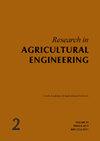Pyrolysis of wheat and barley straw
Q3 Agricultural and Biological Sciences
引用次数: 7
Abstract
Pyrolysing agricultural crop residues and other biomass constitutes a newer method of transforming often difficult, waste materials into a novel type of soil amendment/additive. Simultaneously, this process also makes it possible to exploit part of the energy released in the agricultural production. Biochar, viewed as the solid product of biomass pyrolysis, is a remarkable, porous material, rich in carbon. Two agricultural crop residues, such as wheat and barley straw, were selected for the experimental studies. The results indicate that the practical temperature for the production of biochar from the two explored materials occurs in the vicinity of 600 °C. Starting at this temperature, the biochar produced complies safely with the principal European Biochar Certificate standards (EBC 2012). Thus, for the wheat straw and barley straw – originated char, the content of the carbon amounts to 67.2 and 67.0 mass %, the atomic ratio H : C is as large as 0.032 and 0.026, and the specific surface area amounts to 217 and 201 m2⋅g–1, respectively.小麦和大麦秸秆的热解
热解农业作物残留物和其他生物质构成了一种将通常困难的废物转化为新型土壤改良剂/添加剂的新方法。同时,这一过程也为开发利用农业生产中释放的部分能量提供了可能。生物炭是一种优异的多孔材料,富含碳,是生物质热解的固体产物。选取小麦和大麦秸秆两种农作物秸秆进行试验研究。结果表明,这两种材料生产生物炭的实际温度在600℃左右。从这个温度开始,生产的生物炭安全符合主要的欧洲生物炭证书标准(EBC 2012)。由此可见,麦秸和大麦秸秆炭的碳含量分别为67.2和67.0质量%,H: C原子比分别为0.032和0.026,比表面积分别为217和201 m2⋅g-1。
本文章由计算机程序翻译,如有差异,请以英文原文为准。
求助全文
约1分钟内获得全文
求助全文
来源期刊

Research in Agricultural Engineering
Engineering, agriculture-
CiteScore
1.40
自引率
0.00%
发文量
21
审稿时长
24 weeks
期刊介绍:
Original scientific papers, short communications, information, and studies covering all areas of agricultural engineering, agricultural technology, processing of agricultural products, countryside buildings and related problems from ecology, energetics, economy, ergonomy and applied physics and chemistry. Papers are published in English.
 求助内容:
求助内容: 应助结果提醒方式:
应助结果提醒方式:


